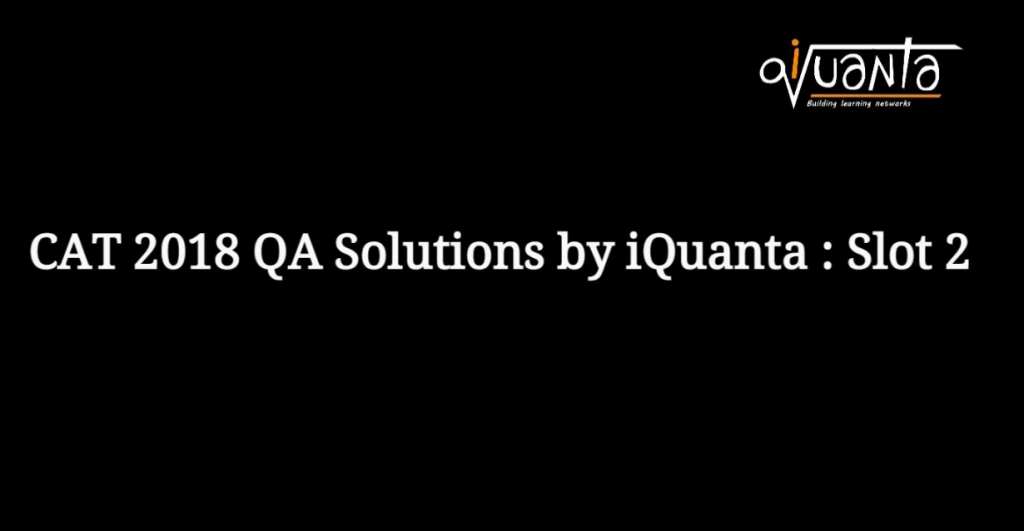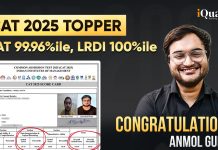
Q.1. If p^3 = q^4 = r^5 = s^6, then the value of logs(pqr) is equal to
Explanation:

We need logs(pqr) so write p,q,r in form of s
p^3 = q^4 = r^5 = s^6, take log of whole equation
so, 3log p=4log q=5log r=6log s
log p=2log s
log q=(6log s)/4
log r=(6log s)/5
logs(pqr)=log pqr/log s=
(log p+log q+log r)/log s=
[ 2log s+(6log s)/4+(6log s)/5]/log s=(47log s)/10 log s=47/10
Q.2. The scores of Amal and Bimal in an examination are in the ratio 11 : 14. After an appeal, their scores increase by the same amount and their new scores are in the ratio 47 : 56. The ratio of Bimal’s new score to that of his original score is
Explanation:

ratio earlier of Amal to bimal=11a/14a
Assume their scores got increased by s
so now, (11a+s)/(14a+s)=47/56
616a+56s= 658a+47s
9s=42a
3s=14a
Bimal’s new score/Bimal’s original score=(14a+14a/3)/(14a)=(1+1/3)=4:3
Q.3. Points A, P, Q and B lie on the same line such that P, Q and B are, respectively, 100 km, 200 km and 300 km away from A. Cars 1 and 2 leave A at the same time and move towards B. Simultaneously, car 3 leaves B and moves towards A. Car 3 meets car 1 at Q, and car 2 at P. If each car is moving in uniform speed then the ratio of the speed of car 2 to that of car 1 is
Explanation:

speeds of cars be c1, c2, c3
c1,c3 meet at Q
so 200/c1=100/c3
c1/c3=2….eq1
now
c3,c2 meet at P
so 200/c3=100/c2
so c3/c2=3 ….eq2
from eq 1 and 2
c2/c1=1:4
Q.4. A water tank has inlets of two types A and B. All inlets of type A when open, bring in water at the same rate. All inlets of type B, when open, bring in water at the same rate. The empty tank is completely filled in 30 minutes if 10 inlets of type A and 45 inlets of type B are open, and in 1 hour if 8 inlets of type A and 18 inlets of type B are open. In how many minutes will the empty tank get completely filled if 7 inlets of type A and 27 inlets of type B are open?
Ans. 48 mins
Explanation:
volume of tank=lcm(30 min, 60 min)=60
given
30(10a+45b)=60
and
60(8a+18b)=60
solving above two equations
a=1/20, b=1/30
we need to find 60/(7a+27b)=3600/75=48 min
Q.5. If the sum of squares of two numbers is 97, then which one of the following cannot be their product?
Explanation:

a^2+b^2=97
using am>=gm
(a^2+b^2)/2 >=(a^2*b^2)^1/2
so ab<=97/2=48.5
so eliminate option greater than 48.5
so 64
Q.6. On a triangle ABC, a circle with diameter BC is drawn, intersecting AB and AC at points P and Q, respectively. If the lengths of AB, AC, and CP are 30 cm, 25 cm, and 20 cm respectively, then the length of BQ, in cm, is

Explanation:
Join CP and BQ
now CP,BQ are altitudes of triangle ABC since angle in a semicircle is 90
so equate the area using both altitudes
1/2*30*20=1/2*25*BQ
BQ=24
Q.7. If A = {6^2n -35n -1: n = 1,2,3,…} and B = {35(n-1) : n = 1,2,3,…} then which of the following is true?
1. At least one member of A is not in B
2. Neither every member of A is in B nor every member of B is in A
3. Every member of B is in A.
4. Every member of A is in B and at least one member of B is not in A

Explanation:
puttng n=2 in B , we get option 4 as the answer
Q 8. If N and x are positive integers such that N^N = 2^160 and N^2 + 2^N is an integral multiple of 2^x, then the largest possible x is

Explanation:
N^N=2^160=32^32
So N=32
N^2+2^N=32^2+2^32=2^10+2^32=2^10(1+2^22)
so max value of x=10
Q.9. The strength of a salt solution is p% if 100 ml of the solution contains p grams of salt. If three salt solutions A, B, C are mixed in the proportion 1 : 2 : 3, then the resulting solution has strength 20%. If instead the proportion is 3 : 2 : 1, then the resulting solution has strength 30%. A fourth solution, D, is produced by mixing B and C in the ratio 2 : 7. The ratio of the strength of D to that of A is
1. 1 : 3
2. 3 : 10
3. 1 : 4
4. 2 : 5

Explanation:
Here when volume of A and C are changing then strength is increasing by 10%,
Given, A+2B+3C=20%,
3A+2B+C=30%
so D would be 2B+7C
solving these
D/A=1/3
Q.10. Points A and B are 150 km apart. Cars 1 and 2 travel from A to B, but car 2 starts from A when car 1 is already 20 km away from A. Each car travels at a speed of 100 kmph for the first 50 km, at 50 kmph for the next 50 km, and at 25 kmph for the last 50 km. The distance, in km, between car 2 and B when car 1 reaches B is

Explanation:
time taken by car 1
D=130 km
for 30 km speed =100 , time= 18 mins,
for next 50 km , speed=50 , time= 60 mins
for last 50 km time 120 mins
so total time=198 mins,
for car 2
1st 50 km, speed=100, time=30mins,
next 50 km , speed=50, time=60 minutes
so 90 minutes done
left time=108 minutes or 1.8 hrs
speed =25
Distance covered by car 2=25*1.8=45 km
, so distance left 50-45=5km
Q. 11. The smallest integer n for which 4^n > 17^19 holds, is closest to
1. 33 2. 39 3. 35 4. 37

Explanation:
nlog4=19log 17
log 17 is slightly greater than log 16 so assume log 17 approximately equal to log 16=4log 2
2n log 2=19*4 log 2
n=38.xx
hence smallest value of n=39
Q.12: 1/log 2 100-1/log 4 100+1/log 5 100-1/log 10 100+1/log 20 100-1/log 25 100+1/log 50 100
1. −4 2. 10 3.1/2 4. 0

Explanation:
1/log 100[log 2- log 4 +log 5- log 10+ log 20- log 25+ log 50]
=1/log 100[(log 2 +log 5 +1/log 20 +log 50)-(log 4+log 10+log 25)]
=1/log 100[log 10000-log 1000]
=[4-3]/log 100=
1/2
Q.13. The value of the sum 7 x 11 + 11 x 15 + 15 x 19 + …+ 95 x 99 is

Explanation:
Since unit digits of all options are different so, find out unit digit of the sum
( 7 x 11 + 11 x 15 + 15 x 19 + 19 x 23+ 23 x 27 + 27 x 31…+ 95 x 99)
write unit digits of each product and check when do they repeat .
like here, (7 x 11 + 11 x 15 + ..+ 23 x 27)…group 1
now units digits repeat from (27 x 31 to 43 x 47) ..group 2
then 47 x 51 to 63 x 67.. group 3
then 67 x 71 to 83 x 87…group 4
then atlast 87 x 91 +91 x 95 +95 x 99..group 5
so we have four groups having same digits and calculate unit digit of group 5 separately
so we have 4(7+5+5+7+1)+(7+5+5)
=4*5+7
=7 as the final unit digit
hence option 2
Approach 2:
Using Sigma of a series whose general term is in AP
sum=[(last term)*(forward term)-(1st term)*(reverse term)]/(d*number of terms in formula)
forward term is next terms that should have occurred after last term
reverse term is the term that would have occurred before first term
d= common difference
number of terms in formula=count number of terms which are being multiplied in (last term)*(forward term)=(95*99)*(103)
so here number of terms in formula =3
Sum=[(95*99)*(103)-(7*11)*(3)]/(4*3)=80707
Q.14. A parallelogram ABCD has area 48 sqcm. If the length of CD is 8 cm and that of AD is s cm, then which one of the following is necessarily true?
1. 5≤s≤7
2. s≠6
3. s≤6
4. s≥6

Explanation:
area of parallelogram=a*b*sin theta
where a,b are lengths of sides and theta is the angle between them
so absin theta=48
8s*sin theta=48
s*sin theta=6
sin theta=6/s
so sin theta must be <=1
so s>=6
Q.15. The smallest integer n such that n^3 – 11n^2 + 32n – 28 > 0 is

Explanation:
n^2(n-11)+32(n-11)+324 >0
(n-11)(n^2+32)+324 >0
n=8 satisfies
Q.16. There are two drums, each containing a mixture of paints A and B. In drum 1, A and B are in the ratio 18 : 7. The mixtures from drums 1 and 2 are mixed in the ratio 3 : 4 and in this final mixture, A and B are in the ratio 13 : 7. In drum 2, then A and B were in the ratio

Explanation:
here Concentration of A in drum 1= 18/25
and suppose in drum 2 it is K and in final mixture it is 13/20
so 13/20 = (18/25*3 +4k)/7,
239/400=k,
so
A=239,
B=161
Q.17. From a rectangle ABCD of area 768 sq cm, a semicircular part with diameter AB and area 72π sq cm is removed. The perimeter of the leftover portion, in cm, is

Explanation:
768=l*b
area of semicircle=72π
π r^2/2=72π
r=12
AB=24, BC=32, CD=24, DA=32
so perimeter of leftover portion
BC+CD+DA+semicircle=32+24+32+12π =88+12π
Q.18. Ramesh and Ganesh can together complete a work in 16 days. After seven days of working together, Ramesh got sick and his efficiency fell by 30%. As a result, they completed the work in 17 days instead of 16 days. If Ganesh had worked alone after Ramesh got sick, in how many days would he have completed the remaining work?

Explanation:
total work=lcm(16,7,17)=16*7*17
so let R,G be rate of doing work of Ramesh, Ganesh
16(R+G)=16*7*17
R+G=119…eq1
so work done by them in 7 days=7(R+G)=833
so remaining work=16*7*17-833=1071
now R becomes 0.7R
so remaining work is done in 10 days so
10(0.7R+G)=1071
0.7R+G=107.1..eq2
solving eq1 and 2
0.3R=11.9
R=119/3
G=238/3
so
We need 1071/G=(1071*3)/238=13.5
Q.19. The area of a rectangle and the square of its perimeter are in the ratio 1 ∶ 25. Then the lengths of the shorter and longer sides of the rectangle are in the ratio
1. 1:3
2. 3:8
3. 2:9
4. 1:4

Explanation:
l*b/4(l+b)^2=1/25
25lb=4l^2+4b^2+8lb
divide whole equatio by lb
25=4l/b+4b/l+8
assume l/b=x
so 4x+4/x=17
so x=1/4=l/b
Q.20. A chord of length 5 cm subtends an angle of 60° at the centre of a circle. The length, in cm, of a chord that subtends an angle of 120° at the centre of the same circle is
1. 6√2
2. 2π
3. 5√3
4. 8

Explanation:
Perpendicular from centre on chord bisects the chord
so sin 30=(2.5)/r
r=5
let the length of the chord be c
now sin 60=(c/2)/5
c=5rt3
Q.21. A tank is emptied everyday at a fixed time point. Immediately thereafter, either pump A or pump B or both start working until the tank is full. On Monday, A alone completed filling the tank at 8 pm. On Tuesday, B alone completed filling the tank at 6 pm. On Wednesday, A alone worked till 5 pm, and then B worked alone from 5 pm to 7 pm, to fill the tank. At what time was the tank filled on Thursday if both pumps were used simultaneously all along?
1. 4:36 pm
2. 4:24 pm
3. 4:48 pm
4. 4:12 pm

Explanation:
assume filling starts at t pm
Assume volume =v
so (8-t)a=v..eq1
similarly
(6-t)b=v..eq2
also (5-t)a+2b=v…eq3
equating equations 1,2
3a=2b
putting this in eq3 we get t=2
so filling starts at 2 pm
so A fills in 6 hrs
B fills in 4 hrs
so volume=6*4=24
so A,B together fill in 24/(4+6)=2.4 hrs
so on thursday filling stops at 4:24 pm
Q.22. Gopal borrows Rs. X from Ankit at 8% annual interest. He then adds Rs. Y of his own money and lends Rs. X+Y to Ishan at 10% annual interest. At the end of the year, after returning Ankit’s dues, the net interest retained by Gopal is the same as that accrued to Ankit. On the other hand, had Gopal lent Rs. X+2Y to Ishan at 10%, then the net interest retained by him would have increased by Rs. 150. If all interests are compounded annually, then find the value of X + Y.

Explanation:
interest retained by gopal=net difference between interest given to ankit and interest earned from ishat
so 0.1(X+Y)-0.08X=0.08X
and
when money lent was gopal was X+2Y
0.1(X+2Y)-0.08X=0.08X+150
from first equation Y=0.6X
putting this in second equation X=2500
Y=1500
so X+Y+4000
Q.23. In a tournament, there are 43 junior level and 51 senior level participants. Each pair of juniors play one match. Each pair of seniors play one match. There is no junior versus senior match. The number of girl versus girl matches in junior level is 153, while the number of boy versus boy matches in senior level is 276. The number of matches a boy plays against a girl is

Explanation:
43 junior,
51 senior,
43c2=903 total matches here,
girls vs girls here nc2=153, n=18, so 18 girls here
and 25 boys so, boys vs boys matches =25c2=300
so in junior boys vs girls matches =903-(153+300)=450.
In senior total matches =51c2=1225,
boys vs boys matches here nc2=276, n=24 boys
so 27 girls and girls vs girls matches here =27c2=351,
so in this case boys vs girl match =1275-(276+351)=648,
total matches=450+648=1098
Q.24. On a long stretch of east-west road, A and B are two points such that B is 350 km west of A. One car starts from A and another from B at the same time. If they move towards each other, then they meet after 1 hour. If they both move towards east, then they meet in 7 hrs. The difference between their speeds, in km per hour, is

Explanation:
350/(a+b)=1
a+b=350..eq1
7(b-a)=350
b-a=50
a=200
b=150
difference in speeds =50 kmph
Q.25. Let t1, t2,… be real numbers such that t1+t2+…+tn = 2n2+9n+13, for every positive integer n ≥ 2. If tk=103, then k equals

Explanation:
t1+t2…..tn=2n^2+9n+13, n>=2
tk=103 then k=?,
for n=2,
t1+t2=39,
n=3,
t1+t2+t3=58
which gives t3=19,
similarly
t4=23,
t5=27
so AP of difference 4 is formed
so 103 will be, (103-19)/4 +1= 22 , since initial term was 3rd so shift each term by 2 so
22+2=24
so k=24
Q.26. How many two-digit numbers, with a non-zero digit in the units place, are there which are more than thrice the number formed by interchanging the positions of its digits?
1. 5
2. 7
3. 8
4. 6

Explanation:
only 6 numbers follow the condition ,which are
91>3*19
92>3*29
81>3*19
71>3*19
61>3*19
51>3*19
so 6 numbers
Q.27. The arithmetic mean of x, y and z is 80, and that of x, y, z, u and v is 75, where u=(x+y)/2 and v=(y+z)/2. If x ≥ z, then the minimum possible value of x is

Explanation:
(x+y+z)= 240,
(x+y+z+u+v)= 375,
simplifying these we get x+z+2y=270
which gives y=30,
now x+z=210, since x>=z
so min x =105
Q.28. Let a1, a2, … , a52 be positive integers such that a1 < a2 < … < a52. Suppose, their arithmetic mean is one less than the arithmetic mean of a2, a3, …, a52. If a52 = 100, then the largest possible value of a1 is
1. 23
2. 45
3. 48
4. 20

Explanation:
Let AM of a2 to a52=A, from above we can comprehend that
when a1 added the AM decreased by 1 so we can write (A-a1) /52 =1
A-a1=52, a1= A-52
for largest a1 we need largest A that’s AM of a2 to a52 since a52=100, we can take all consecutive integers from a2=50 to a52=100, now there AM will be 75, so max AM or A can be 75 so max a1 can be 75-52=23
Q.29. Let f(x)=max{5x, 52-2×2}, where x is any positive real number. Then the minimum possible value of f(x) is

Explanation:
Equate both
5x=52-2x^2
x=(-5+-21)/2
x=-13/2,4
putting x=4
5*4=20
Q.30. If a and b are integers such that 2x^2 −ax + 2 > 0 and x^2 −bx + 8 ≥ 0 for all real numbers x, then the largest possible value of 2a−6b is

Explanation:
2x^2-9x+2 >0, x^2-bx+8>=0.
max of 2a-6b=?
b^2-4ac<0
since quadratic is positive so D is negative
same in second case
so a^2-16<0,
a lies in (-4,4)
and b^2-32<0
so b lies in[-4root2,4root2],
Now to maximise 2a-6b we need to take b in negative
and since it is an integer so nearest integer less than 4root2=5 so b=-5 and
max a=3, as a can’t be 4 so max of 2a-6b= 2*3-6(-5) =36
Q.31. For two sets A and B, let AΔB denote the set of elements which belong to A or B but not both. If P = {1,2,3,4}, Q = {2,3,5,6,}, R = {1,3,7,8,9}, S = {2,4,9,10}, then the number of elements in (PΔQ)Δ(RΔS) is
1. 9
2. 7
3. 8
4. 6

Explanation:
remove elements common in both while doing the operation
in (PΔQ)={1,4,5,6}
in (RΔS)={1,3,7,8,10}so (PΔQ)Δ(RΔS) is={3,4,5,6,7,8,10} 7 elements
Q.32. A 20% ethanol solution is mixed with another ethanol solution, say, S of unknown concentration in the proportion 1:3 by volume. This mixture is then mixed with an equal volume of 20% ethanol solution. If the resultant mixture is a 31.25% ethanol solution, then the unknown concentration of S is

Explanation:
In 2nd mixing, 2 equal quantity of let say x% and 20% ethanol are mixed to get 31.25% of the mixture ethanol.
So x+20/2=31.25
Or,x=42.5
The 42.5% ethanol mixture we are getting by mixting solution A of 20% to solution S of y% say in 1:3 ratio.
Using allegations
20%=>42.5%=>y
So(y-42.5)/22.5%=1/3
Or,3y=150
Or,y=50
Q. 33. A jar contains a mixture of 175 ml water and 700 ml alcohol. Gopal takes out 10% of the mixture and substitutes it by water of the same amount. The process is repeated once again. The percentage of water in the mixture is now
1. 20.5
2. 30.3
3. 35.2
4. 25.4

Explanation:
total mixture=875 ml
10% taken out=87.5 ml removed
so 17.5 ml water and 70 ml alcohol removed
so 70 ml extra water is added
now 245 ml water, 630 ml alcohol
again 10% mixture i.e 87.5 ml removed in which alcohol is 63 ml
so 63 ml water is added again
now water=245+63=308 ml
so % age of water=(308/875)*100=35.2
Q.34. A triangle ABC has area 32 sq units and its side BC, of length 8 units, lies on the line x = 4. Then the shortest possible distance between A and the point (0,0) is
1. 4 units
2. 8 units
3. 2√2 units
4. 4√2 units

Explanation:
area=1/2*b*h=1/2*8*h=32
h=8
A and origin will be as close as possible when A lies on x axis so A is at -4,0 because height=8
so shortest distance =4






